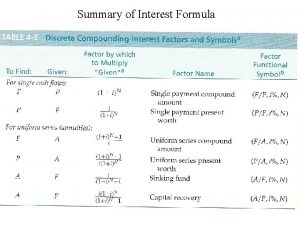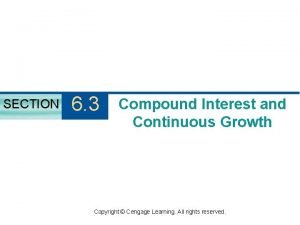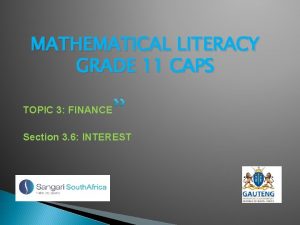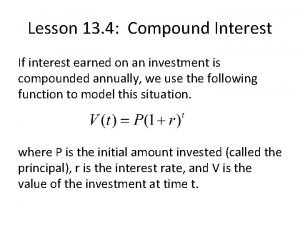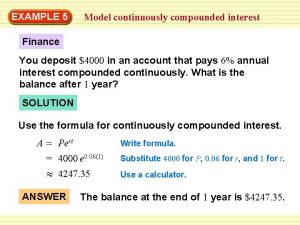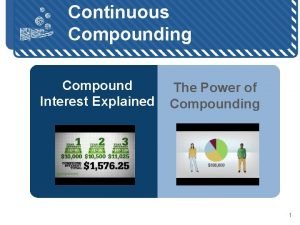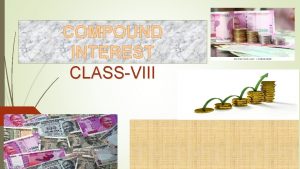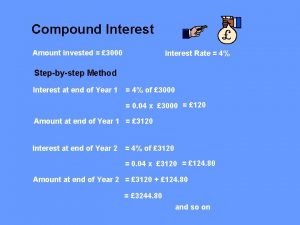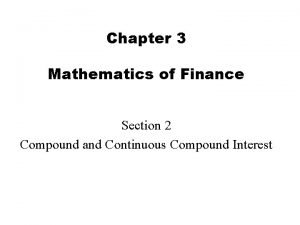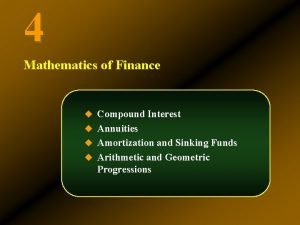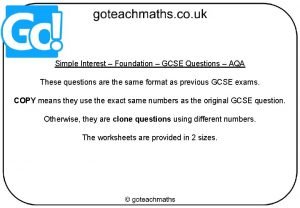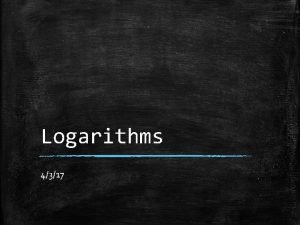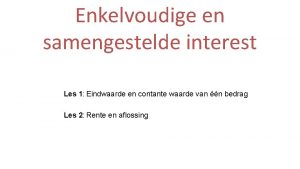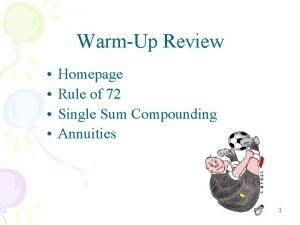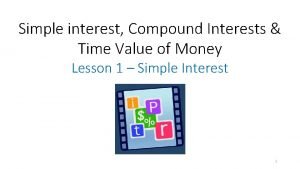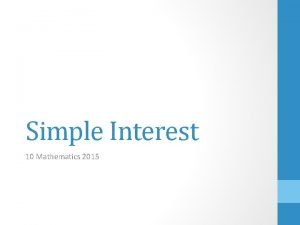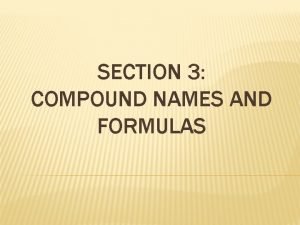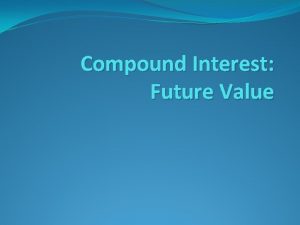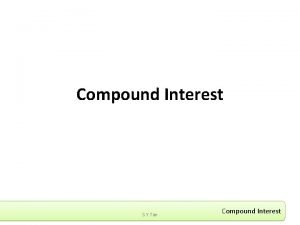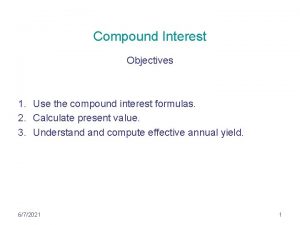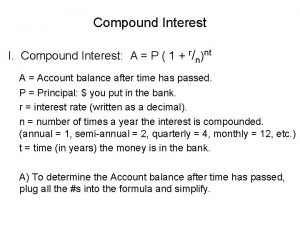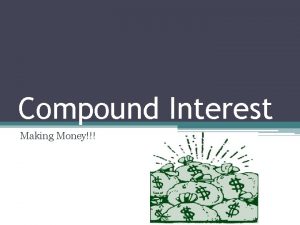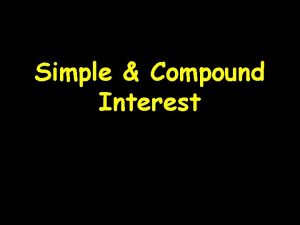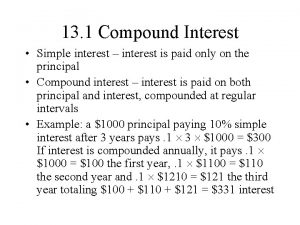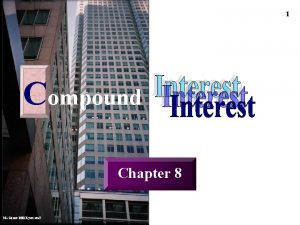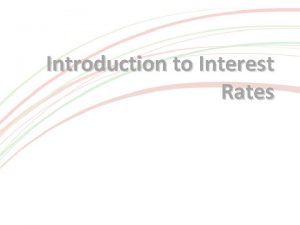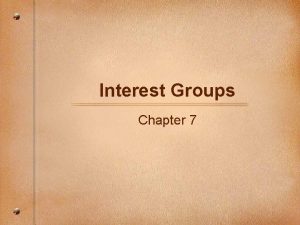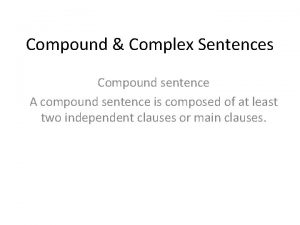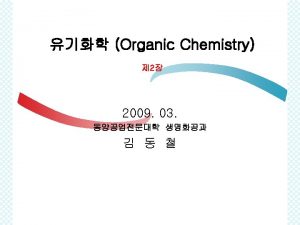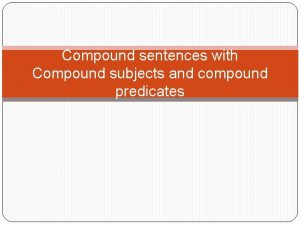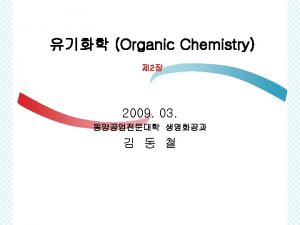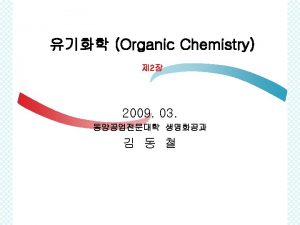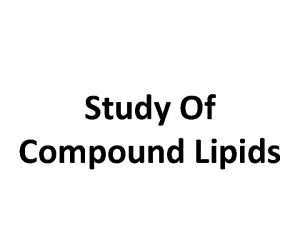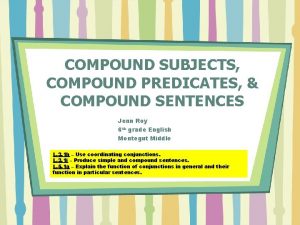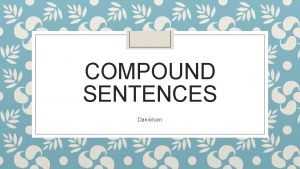Chapter 10 Compound Interest Section 1 Introduction Compound





























- Slides: 29

Chapter 10 Compound Interest

Section 1 Introduction - Compound Interest

Compound Interest ¢ …is interest computed not only on the original principle, but also on any previously credited interest.

Visual Comparison ¢ Simple Interest vs Compound Interest $10, 000 invested at 5% over 20 years.

Objective 1 Use I = PRT to compute compound interest.

Comparison using I = PRT o Invest $580 at 3% simple interest for 4 years: o Invest $580 at 3% interest compounded annually for 4 years: $580 x. 03 x 1 = $17. 40 Year 1 $580. 00 x. 03 x 1 = $17. 40 $580 x. 03 x 1 = $17. 40 Year 2 $597. 40 x. 03 x 1 = $17. 92 $580 x. 03 x 1 = $17. 40 Year 3 $615. 32 x. 03 x 1 = $18. 46 $580 x. 03 x 1 = $17. 40 Year 4 $633. 78 x. 03 x 1 = $19. 01 $69. 60 $72. 79

Compounding Period ¢ Interest can be compounded more than The compounding period defines how once a (annually). often in year one year interest is computed on an investment. Interest Compounded: Number of compounding periods in one year: annually 1 semi-annually 2 quarterly 4 monthly 12 daily 365

Practice Compound Interest using I = PRT ¢ ¢ Invest $100 at 3% interest compounded quarterly for 1 y What is the account balance at the end of the year? 1 year 1 = $0. 75 4 1 $100. 75 x 0. 03 x = $0. 76 4 $100 x 0. 03 x 1 = $0. 76 4 1 $102. 27 x 0. 03 x = $0. 77 4 $101. 51 x 0. 03 x Account Balance = $100 + $0. 75 + $0. 76 + $0. 77 = $103. 04

Limitations ¢ What if you are asked to compute this scenario? l $500 invested at 3% interest compounded monthly for 10 years? 1 = $1. 25 12 1 $501. 25 x 0. 03 x = $1. 253 12 $500 x 0. 03 x etc… You will have to do _____ 12 computations just to do the first year. You will have to do a total of 120 computations to cover _____ the full ten years.

Practice Worksheet 1 ¢ Use the Simple Interest Formula to compute compound interest. I = PRT

Compound Interest Introduction to the Compound Interest Formula M = P(1 + i) n

Compound Interest Formula Total number of compounding periods Maturity Value Principle + Interest Earned M = P(1 + i) n Interest rate per compounding period Principle: initial investment

M = P(1 + i) Compounding Period ¢ The compounding period defines how often in one year interest is computed on an investment. Interest Compounded: annually semi-annually quarterly monthly daily Number of compounding periods in one year: Interest Rate per Period (using 6% annual rate) 1 6% 2 4 6% 4 12 6% 12 365 6% 365 n

Practice Setting-up the Formula COMPOUND INTEREST FORMULA

n Practice 1 M = P(1 + i) n M = 100(1 + i) M = 100(1 +. 06) n M = 100(1 +. 06) ¢ $100 invested at 6% interest is compounded annually for 3 years. Interest rate period is: 6% 1 time(s) per year… for 3 years Interest is computed ____ 3

n Practice 2 ¢ M = P(1 + i) n M = 100(1 + . 06 2 )4 $100 invested at 6% interest is compounded semi-annually for 2 years. . 06 Interest rate period is: 6% 2 2 2 time(s) per year… for 2 years Interest is computed ____

n Practice 3 ¢ M = P(1 + i) n M = 100(1 + . 06 4 )12 $100 invested at 6% interest is compounded quarterly for 3 years. . 06 Interest rate period is: 6% 4 4 4 time(s) per year… for 3 years Interest is computed ____

n Practice 4 ¢ M = P(1 + i) n M = 100(1 + . 06 12 )60 $100 invested at 6% interest is compounded monthly for 5 years. . 06 Interest rate period is: 6% 12 12 12 time(s) per year… for 5 years Interest is computed ____

Practice Worksheet 2 ¢ Determine the interest rate period and the number of compounding periods.

Compute Compound Interest M = 100(1 +. 064 )12

Exponents M = P(1 + i) ¢ In the compound interest formula, the n value is an exponent. ¢ Exponents are short-hand notation for repeated multiplication: 6 x 6 x 6 x 6 64 n

Exponents Exponent 5 4 5 x 5 x 5 x 5 Base 4 factors Calculator Sequence: 5 4 = 625 V

Practice Use your calculator to evaluate the following: 3 ¢ 5 = 125 ¢ ¢ 7 6 4 2 = 2401 = 36

Compute w/ Calculator Practice 119. 5618171 0 M = 100(1 + 100 x . 06 4 )12 ( 1 +. 06 ÷ 4 ) $119. 56 yx 12 =

Practice Worksheet 3 ¢ Compute Compound Interest with a Calculator.

Applications Compound Interest

Example 1 of 2 M = P(1 + i). 06 4 7 yrs x 4 times/yr = 28 n 6% ÷ 4 = ¢ ¢ #16, p 408 Vickie Ewing deposits her savings of $2800 in an account paying 6% compounded quarterly and she leaves it there for 7 years. $4248. 22 l Compound Amount = ____ $1448. 22 l Interest = _____ M = 2800(1 + 2800 x . 06 28 4 ( 1 +. 06 ÷ 4 ) ) yx 28 = $4248. 22 – 2800 = $1448. 22

M = P(1 + i) Example 2 of 2 ¢ ¢ #21, p 408 $25, 000 to invest for 1 year. l l n 6% ÷ 4 =. 06 4 1 yrs x 4 times/yr = 4 Loan it out at 10% simple interest for 1 year. Invest it @6% compounded quarterly for a year. • Which option would generate the most interest, and by how much? Simple Interest I = 25, 000(0. 10)(1) $2500 – 1534. 09 = $965. 91 Compound Interest. 06 4 4 M = 25, 000(1 + ) M = $26, 534. 09 I = $26, 534. 09 – 25, 000 $1534. 09

Practice ¢ Ch 10, Section 1 – Compound Interest Textbook Exercise 10. 1 (pages 407 – 410) _____ #2, 3, 6, 7, 9, 16, 17, 19, 21, 23, 25 NOTE: Use the M = P(1 + i)n formula for all the problems where you are to compute compound interest. Because we are using the formula to determine M (as opposed to using a table), our answers may be just a bit different from the book’s answer key.
 Compound interest meaning
Compound interest meaning Nominal v. real interest rates
Nominal v. real interest rates Nominal vs effective interest rate
Nominal vs effective interest rate Chapter 9 section 3 interest groups at work
Chapter 9 section 3 interest groups at work Chapter 9 section 2 types of interest groups
Chapter 9 section 2 types of interest groups Discrete compound interest formula
Discrete compound interest formula Simple interest examples with solutions
Simple interest examples with solutions Compounded continuously formula
Compounded continuously formula Compound interest maths literacy
Compound interest maths literacy Lesson 13 4 compound interest answers
Lesson 13 4 compound interest answers A=pert formula
A=pert formula Pert formula compound interest
Pert formula compound interest Learning objectives of compound interest
Learning objectives of compound interest Compound interest steps
Compound interest steps Example of annual percentage rate
Example of annual percentage rate Compound interest problem example
Compound interest problem example Villanelle characteristics
Villanelle characteristics Gcse simple interest questions
Gcse simple interest questions Logarithm desmos
Logarithm desmos 2-4 explore compound interest
2-4 explore compound interest Society and culture pip
Society and culture pip Simple interest
Simple interest Verschil tussen enkelvoudige en samengestelde interest
Verschil tussen enkelvoudige en samengestelde interest Simple and compound interest practice worksheet answer key
Simple and compound interest practice worksheet answer key 3-5 compound interest formula
3-5 compound interest formula Geometric gradient series calculator
Geometric gradient series calculator Compounding daily formula
Compounding daily formula Formula for simple interest
Formula for simple interest Chapter 6 section 3 compound names and formulas answer key
Chapter 6 section 3 compound names and formulas answer key Concept mapping chapter 10 meiosis 1 and meiosis 2
Concept mapping chapter 10 meiosis 1 and meiosis 2





